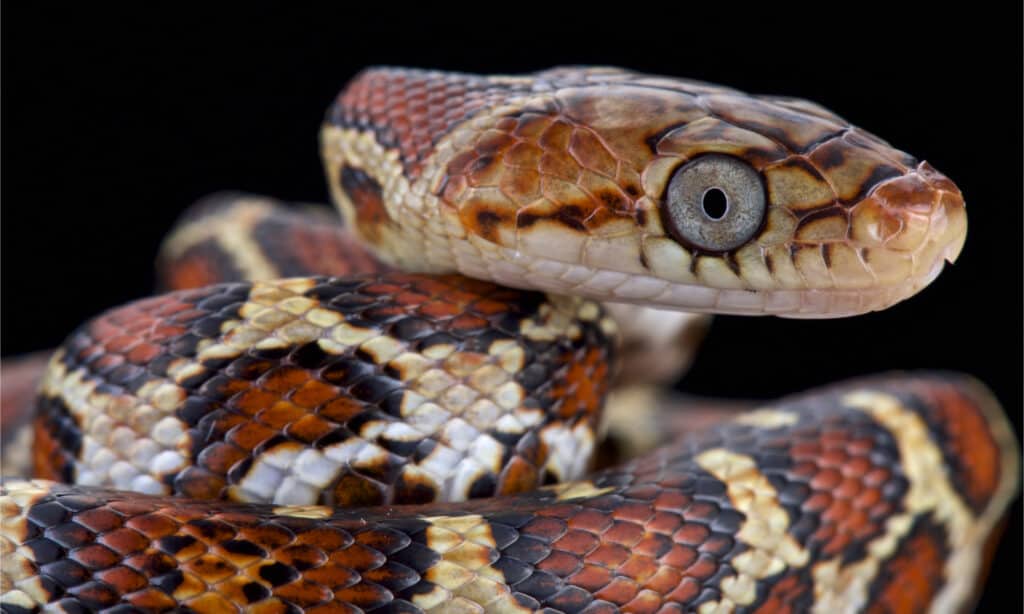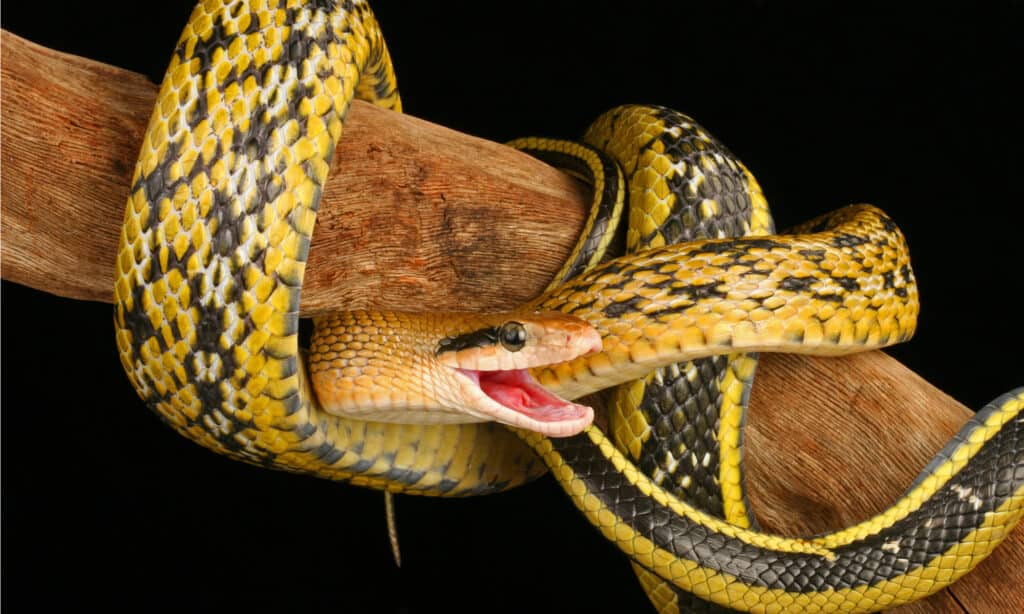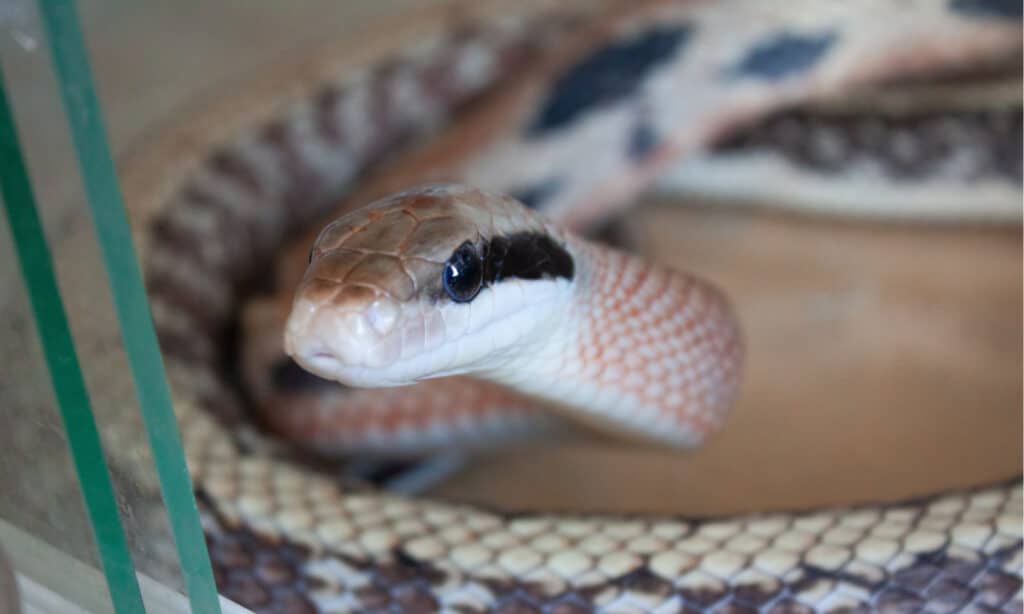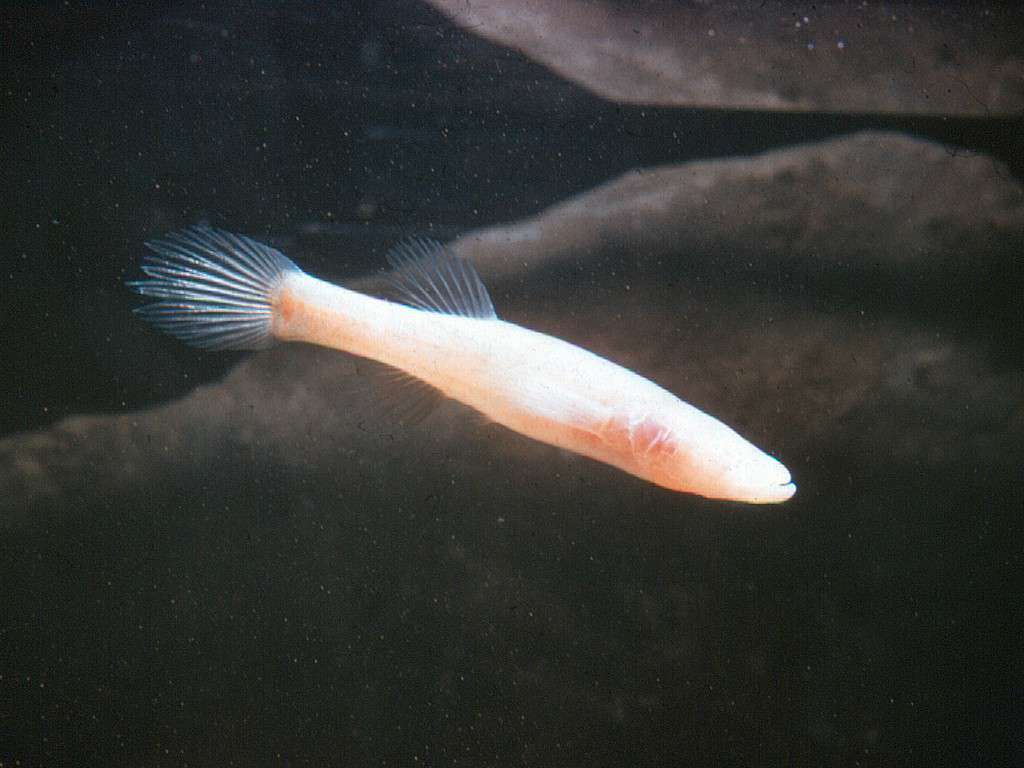In Kantemó town, Yucatan Peninsula of Mexico, a species of snakes have adapted to a rather strange and creepy habitat– a world of complete darkness spent among the countless holes along the ceiling and walls of limestone caves.
These snakes have been known to hang off ceilings to snatch bats out of the air for dinner. But this Kantemó species is not the only snake hanging out with bats in caves. Other species have also been discovered to call caves home.
Let’s take a look at them.
1. Yellow-Red Rat Snake (Pseudelaphe flavirufa)

The yellow-red rat snake is long and heavy, and some individuals may reach a total length of 4 feet.
©reptiles4all/Shutterstock.com
Scientists have identified the snakes inhabiting the Kantemo caves as yellow-red rat snakes. These snakes typically live in caves and are a species of nonvenomous snakes in the family Colubridae. Three subspecies of yellow-red rat snakes are recognized as being valid, including:
- Pseudelaphe flavirufa flavirufa
- Pseudelaphe flavirufa matudai
- Pseudelaphe flavirufa pardalina
Physical Description
The yellow-red rat snake is long and heavy, and some individuals may reach a total length of 4 feet (1.22 m), including the tail, which is about 10 inches long. From its name, you can easily identify this species by its mix of yellow and red color patterns. On the dorsal surface, it is yellowish or pale brown with a series of reddish or chestnut-brown spots.
The red spots have black edges and may run together into a zigzag stripe. This snake has an alternating series of smaller lateral spots on each side of the dorsal spots. The belly or underside of the yellow-red rate snake is yellowish, either plain or with small brown spots.
Range and Habitat
The yellow-red rat snake is endemic to Mexico and Central America, and this species is distributed through Honduras, Belize, Nicaragua, and Guatemala. It occurs in many habitats, from dry forests to tropical wet ones.
Kantemó town in the Yucatan Peninsula of Southern Mexico is famous for being home to the “Cave of Hanging Serpent, “where a unique group of yellow-red rat snakes has lived for over 200 years. About three hundred visitors visit the Kantemó cave yearly to observe these unusual serpents that hang off the ceilings of caves.
Diet
The yellow-red rat snake feeds on ground-dwelling animals like rodents and lizards. But due to their ability to adapt to living in the complete darkness of caves, their diet may entirely consist of bats. In a strange fashion, these snakes hang upside down from the ceiling close to the mouth of the cave to catch bats out of the air as they fly by.
2. Beauty Rat Snake (Orthriophis taeniura)

The beauty rat snake is a non-venomous species of semi-arboreal snake belonging to the family Colubridae.
©Audrey Snider-Bell/Shutterstock.com
The beauty rat snake is also called the cave-dwelling snake, the beauty snake, or the cave racer because it hides and essentially lives in caves. It is a non-venomous species of semi-arboreal snake belonging to the family Colubridae. The beauty rat snake has several recognized subspecies, including:
- Ridley’s beauty snake, cave-dwelling rat snake, cave racer (Elaphe taeniura ridleyi) – found in Thailand and Peninsula Malaysia. However, this species is listed as Vulnerable on the China Species Red List.
- Chinese beauty snake (Elaphe taeniura taeniura) – found in China.
- Mocquard’s beauty rat snake (Elaphe taeniura mocquardi) -fFound in southeastern China, northern Vietnam, and the island of Hainan.
- Taiwan/Taiwanese beauty snake (Elaphe taeniura friesei) – found in Taiwan
- Vietnamese blue beauty snake (Elaphe taeniura callicyanous) – found in Vietnam, Thailand, and Cambodia.
- Helfenberger’s beauty snake (Elaphe taeniura helfenbergeri) – found in Myanmar and Thailand.
Physical Description
Beauty rat snakes are moderately robust, long snakes with an average length of about 4–6 feet (1.2 to 1.8 m), including the tail. They have a yellowish-brown to olive ground color, which becomes darker at the end of their tail. This species is easily identifiable owing to its unique appearance.
The snake’s back is distinctly marked with two pairs of round black spots that join together, while the skin on the back of the neck and head are uniform in color. The beauty rat snake has a distinctive black stripe that starts at the back corner of each eye and reaches forward to each corner of the mouth.
The line appears pale cream around the upper labial area of the mouth. The head of the snake is elongated and wider than its neck, and the eyes are moderate in size.
Range and Habitat

Within their range, beauty rat snakes can be found in cold, dark limestone caves and sometimes in forested habitats.
©Hamara/Shutterstock.com
The range of the beauty rat snake covers eastern, southern, and southeastern regions of Asia, except western and northeastern China, which are outside their range.
Though the species is favored in some locations as a pet, certain subspecies are considered invasive in regions of Asia. One of the leading causes of invasion is transport by the pet trade, and some individuals escape or are released by their owners.
Within their range, beauty rat snakes can be found in cold, dark limestone caves and sometimes in forested habitats. Due to their special preference for caves, these snakes are excellent climbers and are known to move along cave walls effortlessly -which contributes to their being great at hunting.
Also, due to their cave-dwelling habits, beauty rat snakes are known as cathemeral; that is, they can be active at random intervals during the day or night; regardless of what time of the day it is outside the cave.
Diet
Beauty rat snakes’ diet primarily consists of ground rodents, such as mice and rats. Because they are skilled climbers, they feed on bats that are roosting within the caves they share. In addition to small mammals, they have also been known to eat birds and bird eggs sometimes.
Even though beauty rat snakes live in enclosed, less accessible caves, they are also threatened by other animals. The main predators of these snakes are birds and mammals.
Other Reptiles that Live in Caves

The blind cavefish is found in underwater bodies of water.
©National Park Service Digital Image Archives / Public Domain
Here is a short list of reptiles that live in caves:
- Grotto Salamander (Eurycea spelaea) – This is a small, semi-aquatic salamander that can be found in caves in the southeastern United States.
- Blind Cavefish (Astyanax mexicanus) – This is a fish species that is found in the dark caves of Mexico and the southern United States.
- Cave Gecko (Tarentola mauritanica) – This is a gecko species that are found in caves in the Mediterranean region.
- Cave Anole (Anolis lucius) – This is a lizard species that are found in caves in the Dominican Republic.
- Jamaican Cave Cricket (Ceuthophilus jamaicensis) – This is a cricket species that are found in caves in Jamaica.
The photo featured at the top of this post is © Blue Iris/Shutterstock.com
Discover the "Monster" Snake 5X Bigger than an Anaconda
Every day A-Z Animals sends out some of the most incredible facts in the world from our free newsletter. Want to discover the 10 most beautiful snakes in the world, a "snake island" where you're never more than 3 feet from danger, or a "monster" snake 5X larger than an anaconda? Then sign up right now and you'll start receiving our daily newsletter absolutely free.
Thank you for reading! Have some feedback for us? Contact the AZ Animals editorial team.






